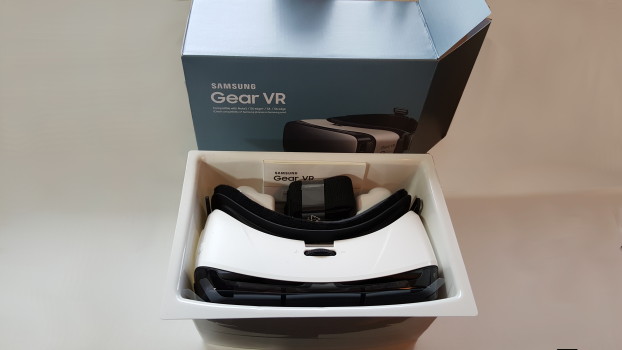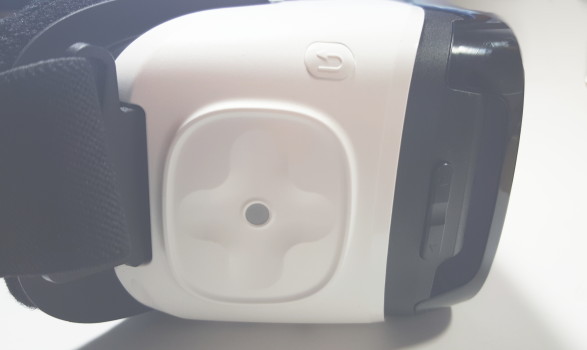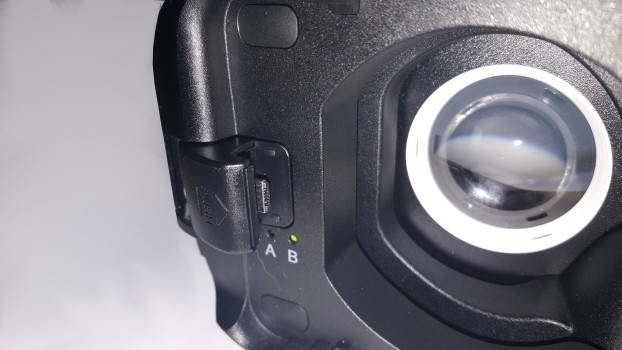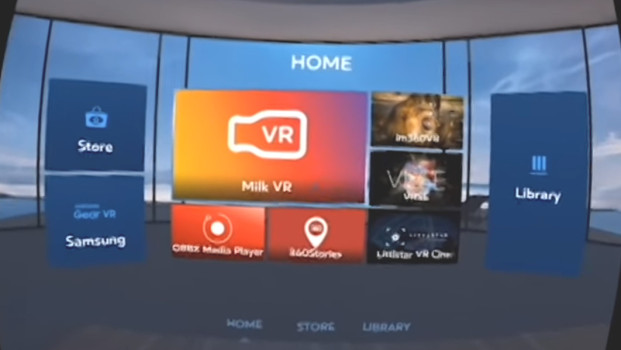My Samsung Gear VR arrived in the mail, and I’m super stoked.

Now I get a chance to try all the cool virtual reality apps that aren’t available for Google Cardboard. And they are AWESOME. Okay, not as awesome as the HTC Vive was awesome — that was Star Trek Holodeck-level awesome — but still really, really good considering it’s a headset that works off your mobile phone.
Should you get one? Read on!
Hardware: Pro
Unlike all the other mobile-based headsets currently on the market, the Samsung Gear VR has extra functionality built into it. Instead of a single control button like the Google Cardboard-compatible headsets, there’s a whole trackpad. Plus, there’s a volume button, and a back button.

The Gear VR also has some extra built-in sensors. For example, it knows when the phone is inside the headset, and it knows when you’re looking at it — and when you’ve put it down. There are also additional built-in motion sensors, for better responsiveness and lower lag.

The lenses can be adjusted, and the whole headset is wide enough to fit over glasses. At least, over my glasses. It also stayed comfortably cool no matter how long I was using it.
Hardware: Con
All this functionality is dependent on having a compatible Samsung phone, which has to snap into the USB connector port. It’s a pretty tight fit. If you have a case on your phone, you’ll have to take it off in order to use the headset.
But the bigger problem is that the headset does not work with smartphones from any other company. So if you have any other brand phone, or an iPhone, you’re out of luck. My recommendation? Try the Ling VR from AliExpress.
User Interface: Pro
The Gear VR stands head-and-shoulders about all the other mobile-based headsets because it actually has a user interface. You put in the phone, and it automatically launches the virtual reality home screen — sorry, the virtual reality home. It’s a giant room in what feels like a mountain lodge.
Hanging in the air in front of you is a screen where you can use the trackpad and the “back” button to navigate your app and media library and the app store.

You can download new apps and switch apps without removing the headset, something you can’t do with other Google Cardboard devices.
The Gear VR also has voice recognition, which is very useful for when you need to enter text. Using an on-screen keyboard is an extremely slow way to enter anything.
User Interface: Con
The user interface feels like the first try at making a virtual user interface. Because, of course, that is, in fact, the case. So the living room is much much larger than it should be. Compare it to the Netflix living room, which is built to human scale. In the Gear VR home living room, you feel like you’re the size of a fly.
You also don’t have a body. You’re just a disembodied camera hanging in the air.
Now I understand that allowing user-customizable avatars, while critical to eventual deployment of social virtual reality experiences, is not an easy thing to do. But a pair of gender-neutral jean-clad legs and a loose sweater might provide a sense of presence and scale that is currently missing.
Apps: Pro
The Gear VR has some excellent apps not currently available on Google Cardboard. They include Netflix, which should probably be everyone’s first download when they get this headset, a Web browser so that you don’t have to take off your headset , and Ocean Rift.
Watch a preview video for Ocean Rift below.
Apps: Con
The selection is currently extremely limited, though this may change if the platform catches on. Right now, however, there are only a few dozen games, compared to hundreds for Google Cardboard.
It’s the classic chicken-and-egg problem. Developers don’t want to spend their time porting their games over until they know there’s a market, and many people are probably going to hold off buying the Gear VR until there’s a better selection of apps.
There’s no YouTube app, for example. You can get to YouTube from the Gear VR web browser, and some videos play very well. Watching traditional videos in full-screen view, for example, is great. But 360-degree and virtual reality videos don’t load correctly most of the times I’ve tried to watch them.
Hulu is also missing, even though the company promised a Gear VR app by late November.
Apps also seem to be priced higher. Lamper VR: Firefly Rescue, for example, is free for Google Cardboard on Android, $0.99 for iOS, but costs $2.99 for the Gear VR.
Some popular games are $9.99 or $14.99, though there are, as I write this, 22 free games as well.
It doesn’t help that the Gear VR app store can only be accessed from the phone, not via a regular web browser. With regular Play Store apps, I can download them via my desktop computer and they somehow magically get transferred to my phone. Not only is it easier and faster to load apps this way, but you can also link to the apps, making it easier for people to find and share them.
Price: Pro
Compared to the hundreds of dollars we’ll be expected to pay for high-end virtual reality headsets next year, $99 is a bargain.
Price: Con
Actually, I don’t have anything bad to say about the price. Yes, it’s more expensive than the $30 Mattel View-Master or the $50 Ling VR, but it is, in fact, a nicer headset. Especially if, as is likely, the app selection and the user interface will continue to improve.
Don’t buy this is if you don’t have a Samsung phone, or expect to be sharing the headset with family or friends who have other phones. And if you’re unsure about the whole virtual reality thing, you might want to hold off until the technology improves — or get a $5 Google Cardboard set first to see whether you like it.
- Analysts predict drop in headset sales this year - March 25, 2025
- OSgrid enters immediate long-term maintenance - March 5, 2025
- OSgrid wiping its database on March 21: You have five weeks to save your stuff - February 15, 2025
